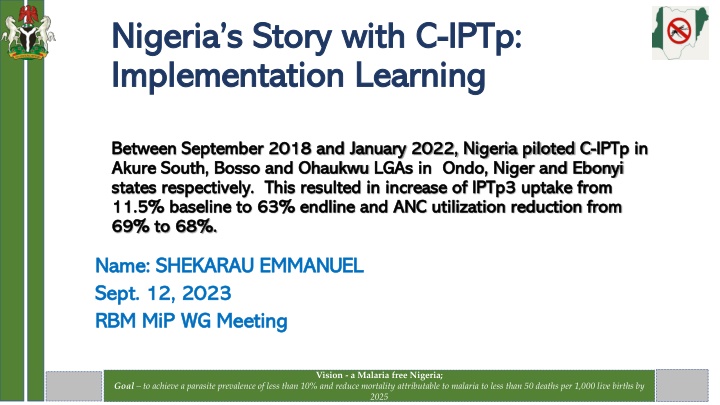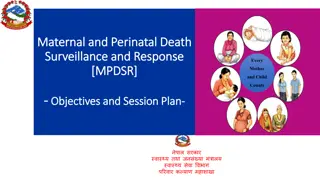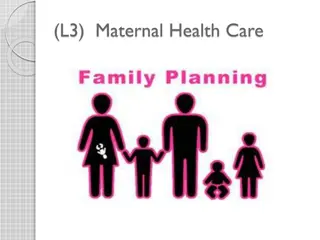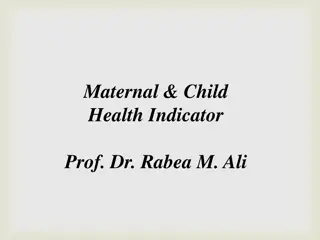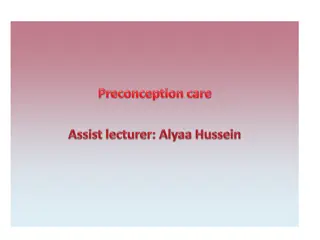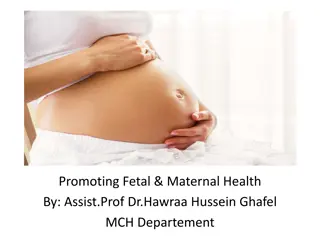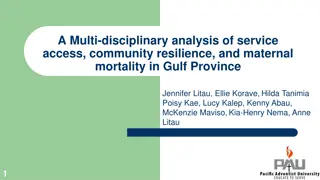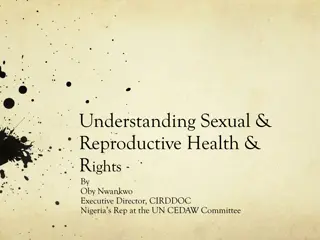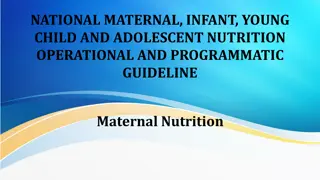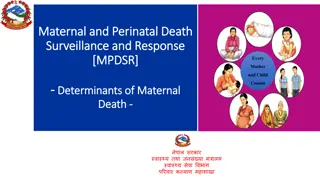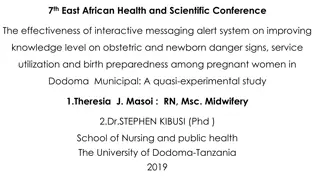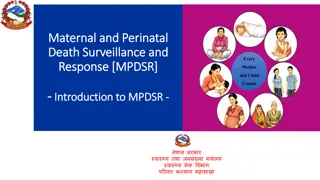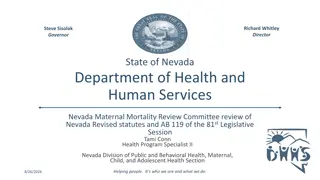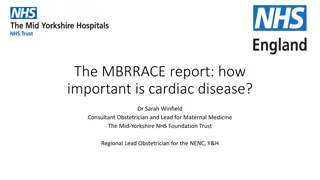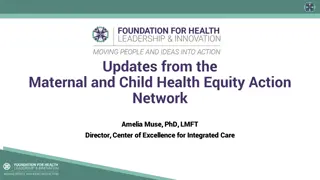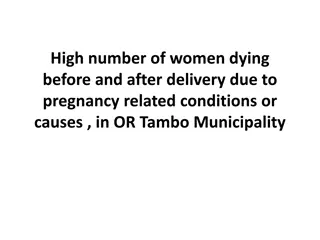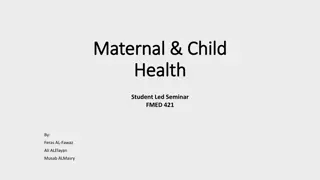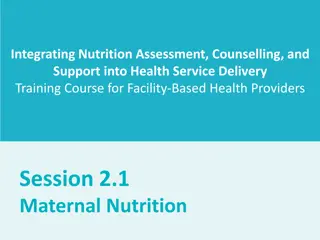Nigeria's C-IPTp Implementation: Improving Maternal Health
Nigeria piloted C-IPTp in selected regions resulting in increased IPTp3 uptake and ANC utilization reduction. Learn about the approach, reasons behind the pilot, and steps taken for implementation.
Uploaded on Feb 26, 2025 | 3 Views
Download Presentation

Please find below an Image/Link to download the presentation.
The content on the website is provided AS IS for your information and personal use only. It may not be sold, licensed, or shared on other websites without obtaining consent from the author.If you encounter any issues during the download, it is possible that the publisher has removed the file from their server.
You are allowed to download the files provided on this website for personal or commercial use, subject to the condition that they are used lawfully. All files are the property of their respective owners.
The content on the website is provided AS IS for your information and personal use only. It may not be sold, licensed, or shared on other websites without obtaining consent from the author.
E N D
Presentation Transcript
Nigerias Story with C Nigeria s Story with C- -IPTp: Implementation Learning Implementation Learning IPTp: Between September 2018 and January 2022, Nigeria piloted C Between September 2018 and January 2022, Nigeria piloted C- -IPTp in Akure South, Bosso and Akure South, Bosso and Ohaukwu Ohaukwu LGAs in Ondo, Niger and Ebonyi LGAs in Ondo, Niger and Ebonyi states respectively. This resulted in increase of IPTp3 uptake from states respectively. This resulted in increase of IPTp3 uptake from 11.5% baseline to 63% endline and ANC utilization reduction from 11.5% baseline to 63% endline and ANC utilization reduction from 69% to 68%. 69% to 68%. IPTp in Name: SHEKARAU EMMANUEL Name: SHEKARAU EMMANUEL Sept. 12, 2023 Sept. 12, 2023 RBM RBM MiP MiP WG Meeting WG Meeting Vision - a Malaria free Nigeria; Goal to achieve a parasite prevalence of less than 10% and reduce mortality attributable to malaria to less than 50 deaths per 1,000 live births by 2025
Nigerias C-IPTp Approach Building on the existing Health Care Systems Community Delivery Structure (CHIPS/ICCM) drug logistics management system to assure the availability of QA-SP for C-IPTp . C-IPTp approach is contained in Nigeria National Malaria Strategic Plan for 2021- 2025. Advocacy to government (state) and partners to sustain and implement the intervention Community Delivery Structure
Why Nigeria Decided to Pilot C-IPTp IPTp is a proven cost-effective public health intervention. However, many pregnant women in Nigeria are unable to receive IPTp due to health system challenges. The consideration arose from the need to address the challenges of Inadequate ANC attendance, and uptake of IPTp1 - IPTp3 that has remained persistently low (as shown in the chart) Consequently, new approaches such as C-IPTp to deliver chemoprevention increase coverage. IPTp Uptake MIS/NDHS Results 2013 - 2021 were explored to
Starting C-IPTp in Nigeria: Overview of Planning & Steps The pilot and implementation involved the Malaria, Reproductive, Maternal, Newborn, Child, Adolescent Health and Nutrition Working Group (MAL-RMNCAH WG); MAL RMNCAH coordinates malaria and reproductive health services in the county. the National Primary Health Care Development Agency (NPHCDA) and the State Primary Health Care Development Agencies to ensure appropriate communication and coordination of project activities and program implementation The National Agency for Food Drug Administration and Control (NAFDAC) responsible for the regulation of drug importation and packaging on QA-SP. Multilateral and bilateral partners such as PMI, USAID, and CDC; local NGOs; and civil society organizations. In order to gain ownership the C-IPTp implementation was built on existing health systems like CHIPS/iCCM
Factors for Site Selection The need to generate evidence from the six-geopolitical zones of the country for decision-making played a key role in the selection process. Map Showing States pilot was conducted In Phase 1, site was in Ohaukwu LGA of Ebonyi state. The climate is ideal for an all year-round transmission of malaria. DHIS2 data show that first ANC attendance coverage relative to the number of annual estimated pregnancies is low (31.2%). IPTp2 coverage is also low (30.2%). A rural homogenous community with a population of 251,733 with 54% female population with estimated annual number of pregnancies of 12,587 In Phase 2, additional two sites in Niger (Bosso LGA) and Ondo states (Akure South LGA ) was added These LGAs were identified based on a high prevalence of malaria, low ANC attendance, and low IPTp3 coverage.
A Closer Look at the CHW The Community Directed Intervention (CDI) approach of community mobilization and meetings was deployed (men, women, youths, and visitors living in the community) The community selected CHWs using CHIPS intervention selection criteria. These criteria and roles include: and ability to read and write, residence in the community where the CHW will be engaged to serve, willingness to volunteer services, Identification of pregnant woman and delivering 1st dose of SP for IPTp while referring to Health facility; promotion of health services submit monthly reports, and attend monthly meetings for CHWs. The project deployed 1 CHW per 120 women of childbearing age 462 CHWs were selected by the community Similarly, in Phase 2, estimated 1,381 CHWs were deployed in the two additional states. The CHIPS Agent are given stipends for transportation to attend review meeting.
Quality Assured SP Sequel to the pilot, procurement of 451,730 doses of Quality-Assured Sulphadoxine-Pyrimethamine was done and supplied to States. Currently, the SP produced in-country are yet to receive WHO prequalification, the Federal Government procures some stock and distributes to the States. To boost sustainability, States encouraged to use avenues like the Basic Health Care Provision Fund (BHCPF), Drug Revolving Fund (DRF) to make these commodities available The Procurement and Supply team conducts and provides annual forecast of needed SP from data entered on the National DHIS At the community level, the NMEP currently working in collaboration with the NPHCDA to include SP to the routine drugs for ANC in order to boost and ensure availability of SP. SP is stored in the HFs in the catchment area where these CHWs are attached to with tracking using commodity management system. This is done routinely by tracking to see the utilization and distribution pattern of CHWs; that is ensuring that pregnant women reached in the community delivery
Reasons for continuing or not continuing C- IPTp There are evidence from the pilot that suggests the benefit of continuing C-IPTp which includes: Accessibility to health services is still an issue especially in rural and hard to reach areas, the role of CHWs in delivery of community intervention which includes C-IPTp is essential. Considering factors like gap in awareness of IPTp and the data of IPTp3 in the country (31% NMIS 2021), it is important to still utilize the opportunity provided through C-IPTp to increase IPTp 3 or more doses. There has been a direct increase in ANC services following human centered design and an increase in the demand for SP There are arrays of support that needs to be properly harnessed in country through proper guidance Currently a World Bank supported project implementing C-IPTp and are being guided
Overcoming Challenges Challenges Mitigation Strategies Sustainability and scale up of c-IPTp Continuous advocacy to State and Local Governments to ensure taking ownership to sustain community based interventions which includes c-IPTp by adopting the sustainability plan developed by Jhpiego Payment of stipends to CHWs/CHIPS Agent involved in c-IPTp Prompt payment of stipends to CHWs, this can be done by strict adherence to the BHCPF allocation and developing a separate payment platform for the cadre Weak referral system following delivery of IPTp in the community CHWs are to follow a hand-held approach which ensure that they follow-up with pregnant women even after SP given to ensure they attend ANC services
Summary Takeaways Nigeria has Included C-IPTp in the National Malaria Strategic Plan (NMSP) 2021-2025; however there is an urgent need to move forward the Strategy and harmonize the scope of work for CHIPS program to include SP at the community level Although, there are still challenges in the scale up of C-IPTp, it is evident that if done properly it will contribute to increase in the coverage of IPTp and ANC attendance which has remained low in the country There is an urgent need to mobilise resources domestically and through donor agencies for the C- IPTp intervention to improve the persistent low coverage observed over the years Nigeria is making efforts at securing WHO pre-qualification for SP manufacturing by Local Pharmaceutical Companies
